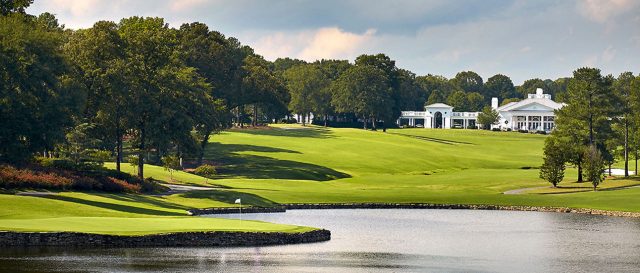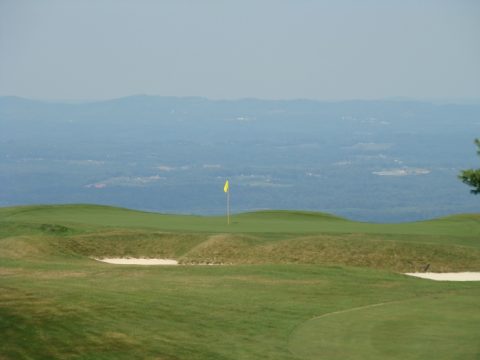CHARLOTTE – If there’s one superlative you can say about Quail Hollow Club, the swag is terrific. If there’s two, well...
The pros, the PGA of America and the club’s guests love Quail Hollow. At its yearly PGA Tour event, it’s the reddest of golf’s red carpets. Lavish gifts, extravagant meals, glittering parties, palatial hotel rooms – it’s all part of the “Quail Hollow experience.” Have a great time all the time, as Spinal Tap keyboardist Viv Savage might say.
So when the 99th PGA Championship came to town the expectation was for the club to totally go over the top. But that hospitality may be getting out in front of a tepid response to a major overhaul.

How did they become so ardent? It’s because North Carolina is a veritable pantheon of the finest courses in the world - and many of them are public. The course of golf design history can trace many of its formative roots to Golden Age designs in the Tar Heel State. Moreover the state is also at the vanguard of movement back to old school architecture as many of its courses are showpieces for this generation’s Second Golden Age of Golf Course Architecture, setting trends in sustainability, conditioning, business model and, of course, design strategy.
Sadly, Quail Hollow is not one of them.
We took an informal poll of about four dozen golf architects, golf design experts and well-traveled players and asked them to list their top 10 courses in the state. Then we added up the scores. It’s unscientific, to be sure, but it’s also remarkably accurate according to each participant. Quail Hollow isn’t even in their top 10. Here’s the list, as they saw it:
- Old Town Club, the last great golf course of Perry Maxwell, recently brilliantly renovated by Coore and Crenshaw
- Pinehurst No. 2
- Pine Needles, which hosted two U.S. Women’s Opens
- Wade Hampton, where the Great Smokeys meet the Blue Ridge
- Tobacco Road, called “The Most Adventurous Golf Club in America”
- Mid-Pines, which recently underwent a wildly successful restoration by Kyle Franz
- Roaring Gap, which was architect Donald Ross' and developer Leonard Tufts’s summertime retreat from the heat of Pinehurst
- The Dormie Club, the haute new course designed by Coore and Crenshaw
- Grandfather Mountain, which is Ellis Maples’s masterpiece carved beneath the darkly frowning brow of the mighty mountain itself
- Charlotte Country Club, a Ross which underwent a magnificent restoration by Ron Pritchard
You can quibble about the order of these courses, but most certainly not about the quality. Interestingly – some say most tellingly - the list leaves out all nine of the other Pinehurst Resort courses, although Nos. 4, 7, and 8 are widely lauded by “looky-loos,” players more interested in a course’s natural setting than its strategic design.
Three of those courses can stand shoulder to shoulder with the greatest courses on the planet.
Pinehurst No. 2
Of course, everyone knows Pinehurst No. 2 as Donald Ross’s magnum opus, a masterpiece he tinkered with his entire life. It’s held three U.S. Opens in a fifteen year period, one PGA Championship (in 1936, won by Denny Shute), and it hosted the North and South Open for half a century back when that was considered a major. Its crowned greens are as cunning as any in the world; the turtleback surfaces are a much smaller target than they appear, while the fearsome internal contours make even the shortest putts knee-knockers.

Tobacco Road
Ardent golfers have also become well familiar with Tobacco Road, the most indelible and endearing public design of the late, great Mike Strantz, a.k.a. The Maverick. Called by Golf Magazine “The Most Adventurous Golf Course in America,” Tobacco Road is the edge of the golf map – terra incognita - a place that’s taken on an almost holy reverence among the intelligentsia as a course unapologetically sincere to the formative years of the game, including wildly contoured greens, cavernous bunkers, artistically crafted fairways and the occasional blind shot.
Tobacco Road is completely unlike anything else in North Carolina, or anywhere else, for that matter, this side of Ireland, and they love it for that. As golf design expert Ran Morrissett aptly wrote on GolfClubAtlas.com, “Though Strantz had a flair for the dramatic, his designs are natural extensions of the native terrain.”
Interestingly, a feasibility study was required by the bank providing funding for the project before construction began. It concluded the site was too remote: “a no man’s land too far from Raleigh or Pinehurst to be successful.” It really makes one wonder about these people’s ability to handle our money, and for certain it’s a good thing for us they’re not doctors.
What also set Strantz apart at Tobacco Road and elsewhere was his penchant for designing directly into the teeth of the natural features and for employing the Doctrine of Deception instead of framing the hole like Fazio, his former employer. Rather than spoon-feed the golfer with the shot required to be played, Strantz lets the golfer decide whether to try to take the aggressive line off the tee and succeed or fail depending on how well they both planned the shot and executed it.
Old Town Club
Old Town Club, the top course in our informal poll and last great course of designer Perry Maxwell, employs the same strategy, with multiple angles off the tee instead of dictating where to place the ball. Like Tobacco Road, they are not afraid of the odd blind shot at Old Town either. Home to the Wake Forest University golf team, Lanny Wadkins famously quipped, “I use the library every day. I draw my tee shot on eight off the spire.”

Old Town also helped trigger a wondrous movement towards shaving unsightly swaths of rough. Instead, six fairways interconnect and three others are adjacent; the course uses only bunkers, a stream and the natural undulations of the fairways to define the playing corridors. An important milepost in golf history, Old Town brought to a close the Golden Age of Golf Course Architecture.
Quail Hollow, by contrast, is predictable, dictatorial, Doctrine of Framing golf. Yes, Fazio has redesigned or re-routed the opening six holes to make them more difficult, but the course is still nothing the pros haven’t seen before. As we observed earlier this year, Quail Hollow is a known commodity, so players will not be as intimidated or inexperienced, and scores should be, correspondingly lower.
Rough and length will be the primary defenses. Originally a George Cobb layout, Tom Fazio completed a redesign in 1997 that resulted on the course being awarded a Tour stop in 2003. Fazio returned last year to lengthen the opening holes or create entirely new ones. Two par 4s, Nos. 1 and 3, both measure over 518 yards. Medieval prisoners weren’t put to the rack this much.
Of course there’s the over-hyped, under-designed “Green Mile” closing stretch, a par-5-3-4 sequence totaling almost 1,200 yards. Too long, too watery, too narrow, too rocky and too uninteresting -- they are simply “hard for hard’s sake,” devoid of temptation and, correspondingly, the swings of fortune you get at well-designed half-par holes.
Rough is also anticipated to be a primary defense, just like we used to see at U.S. Opens and at PGA Championships conducted at former U.S. Open venues: five inches long, thick and lush and penal. All this machismo is needed to combat the all out assault on scoring that’s been underway in the past few years; it’s the only way to defend this golf course; players are hitting 400 yard drives now with the unchecked technological advances in equipment and the modern trend toward fitness.

First, Rory McIlroy fired a final-round, 10-under 62 in 2010, including 5 under on the final five holes – to steal the tournament and break the course record by two shots.
Then in 2012 Rickie Fowler not only tied the record with a final round 62, he beat McIlroy and D.A. Points in a playoff to take the trophy and a share of the record.
McIlroy got revenge and the record back in 2015, closing with a 61.
Enough is enough. The pros are licking their chops for a chance to put the Wanamaker Trophy in their goodie bag this weekend along with unlimited swag, and with low numbers readily available in ordinary conditions, the major set-up needs to be much more severe. We can’t be passing out 62s and 61s like Halloween candy at a major championship, and make no mistake, it may be out there, especially if the course is soft or wet.
Quail seems to favor long bombers, and golfers who play well here once tend to play well here perennially. As such McIlroy and Fowler should be the first two names on your handicap sheet, followed by Brooks Koepka and Dustin Johnson. Jon Rahm, as a breakout star this year, is a popular pick, as is Justin Rose, who also plays well here, combining both the length and accuracy to stay abreast of the bomb and gauge crew. Jordan Spieth’s driver needs to be far more accurate if he’s to complete the career Grand Slam this week. He’ll find much more trouble than equipment trucks and blind shots if he starts spraying the ball all over the Queen City.
Jimmy Walker proved last year that sleeper picks do cash in at majors from time to time, and nowhere more than at the PGA. As such Kyle Stanley, Lucas Glover, and Robert Streb have all had solid, if quiet seasons. Finally, watch out for hometown boy Webb Simpson, the 2012 U.S. Open champion. He always plays well in North Carolina and is a member at Quail Hollow.
So pack your sticks and head out for a road trip! Play golf in the morning, then go watch the tournament in the afternoon. Take advantage of all the great golf north Carolina has to offer...or just stuff the goodie bag with another sleeve of balls and free passes to the spa. After all – something for nothing, it never goes out of style.

